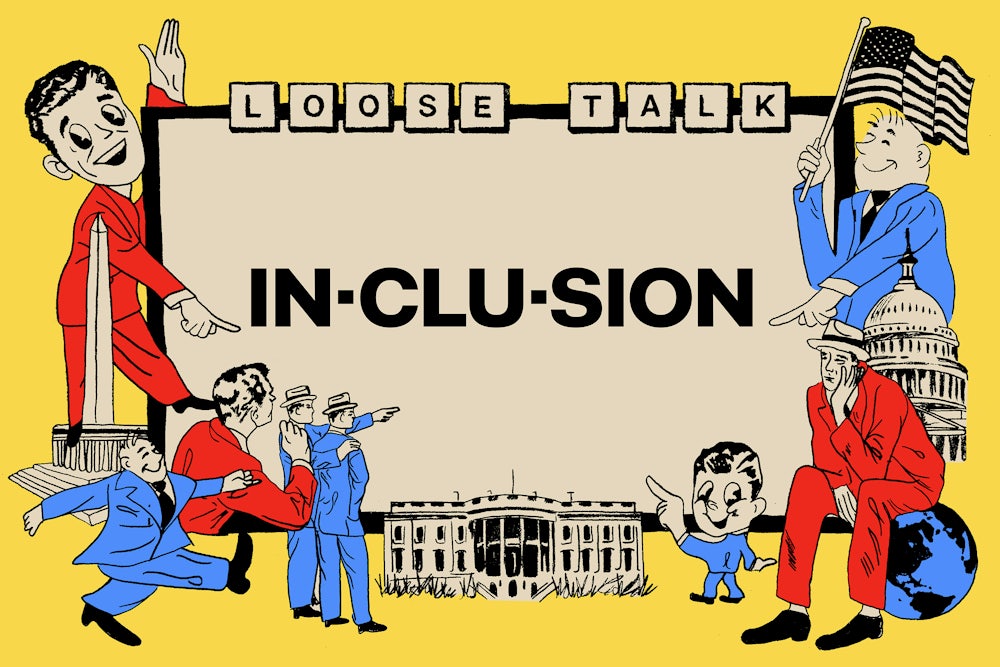Students returning to Harvard this fall may encounter the Office for Diversity, Inclusion, & Belonging, whose mission is to “catalyze, convene, and build capacity for equity, diversity, inclusion, belonging, and anti-racism initiatives .” They might wonder at the difference between “catalyzing” and “convening”; they might ask how much equity you could catalyze just by cutting tuition.
“Inclusion” is usually defined as the way you get “diversity,” the concept to which it’s habitually bound. If diversity is a quantifiable metric—of the racial breakdown of a given workplace, for example—“inclusion” is how you put it into practice. As a McKinsey report puts it, inclusion helps to ensure “accountability among managers, equality and fairness of opportunity, and openness and freedom from bias and discrimination.” The airy academic sincerity of the Harvard office’s mission statement and the McKinsey consultant’s methodical specificity exemplify the peculiar range that “inclusion” manages to achieve. It is at once diversity’s whimsical, unmeasurable sibling, a subjective matter of employees’ and students’ feelings and sense of belonging, and a list of human-resources policy proposals, none of which ever seem to involve a labor union, free tuition, or a robust grievance procedure.
It almost makes you think that the point of “inclusion” initiatives spearheaded by managers is that they never have to end. Why, after all, would one expect bosses to ensure accountability for themselves? Here, the contrast with an older synonym, “integration,” is instructive. Integration, as a word and (at least) as an ideal, is opposed by “segregation”; inclusion, by the much less precise concept of “exclusion.” Integrating a segregated institution attacks its raison d’être, which in the United States was to monopolize power, prestige, and wealth for whites. Integrating it therefore should (at least in theory) change it from the ground up. Making an institution more inclusive, however, just means welcoming more people into it in its current form. A more “inclusive” institution only needs to become a better version of itself. It’s something you should want to be a bigger part of.
Because it does not often identify a responsible party, or a clear cause of the inequality it seeks to remedy, “inclusion” is an apolitical heir to integration. Exclusion can seem like an accident of history, rather than a product of design, and inclusion more a matter of effectiveness than of justice. The suggestion is that “participation” by necessity yields fairness: It is “exclusion” from state and federal government, the professoriate, and the executive suites, rather than those things themselves, that disempowers.
One of the more laughable examples of “inclusion” rhetoric is the story of Sally, a CIA support officer profiled in Diversity & Inclusion at the CIA, a 2014 report by the agency’s Office of Public Affairs. Sally, explains a capsule biography, exemplifies the unconventional life experience that the agency wants to include: No cosseted daughter of the American gentry, she found “resilience” in a childhood spent in a war zone, where she drove armored trucks before she turned 12. There’s just one problem with the story: Her school of hard knocks was 1970s Rhodesia. While the CIA neglects to mention which side young Sally fought on, we can presume from the accompanying stock photo of a white woman that she fought for white minority rule. When “inclusion” can seem to celebrate survivors of the last dying embers of white colonialism, it’s outlived any usefulness it ever had. A question, for would-be CIA agents and others: Do you really want to be included in this?




